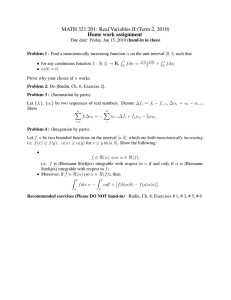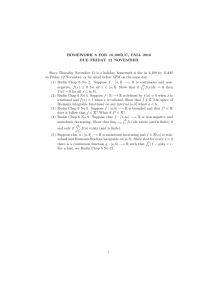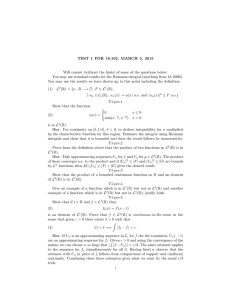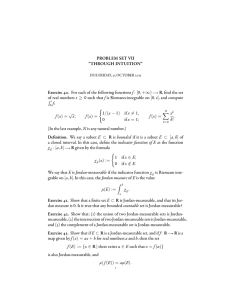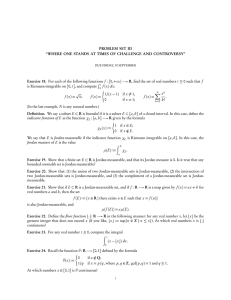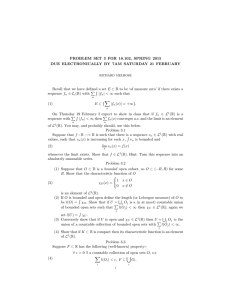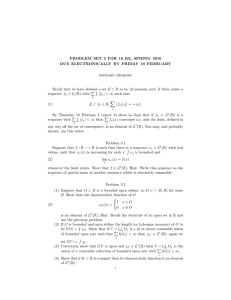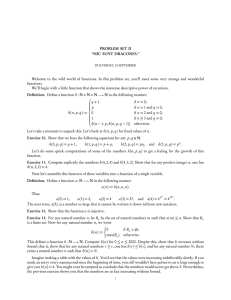SOLUTIONS TO HOMEWORK 8 FOR 18.100B/C, FALL 2010
advertisement
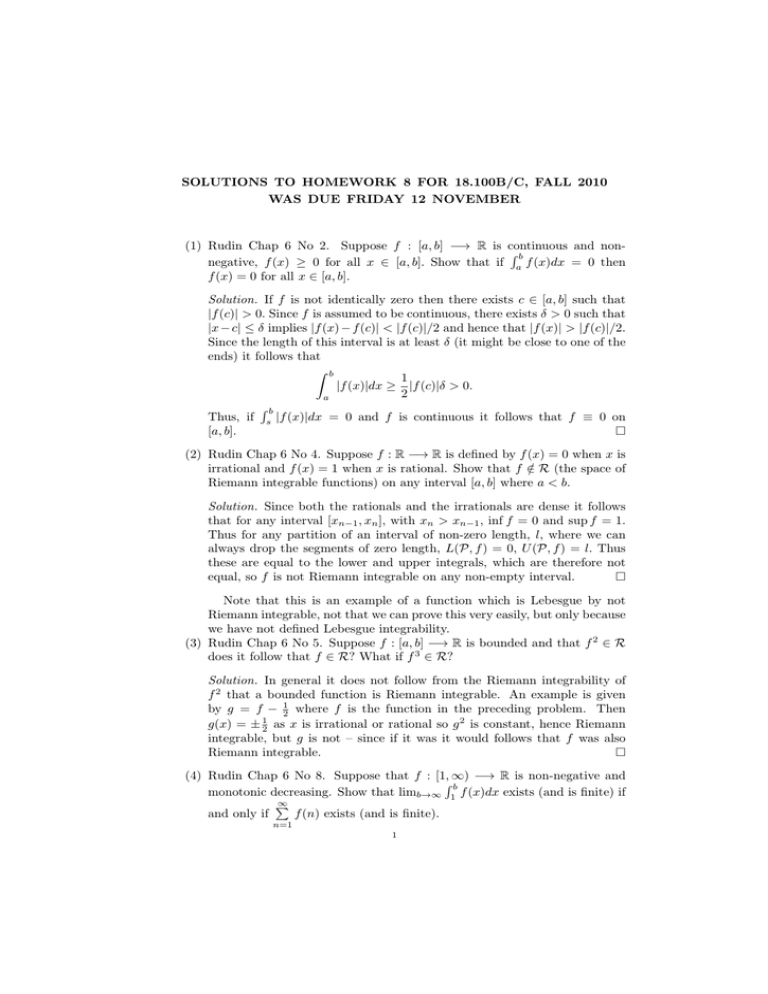
SOLUTIONS TO HOMEWORK 8 FOR 18.100B/C, FALL 2010 WAS DUE FRIDAY 12 NOVEMBER (1) Rudin Chap 6 No 2. Suppose f : [a, b] −→ R is continuous and nonRb negative, f (x) ≥ 0 for all x ∈ [a, b]. Show that if a f (x)dx = 0 then f (x) = 0 for all x ∈ [a, b]. Solution. If f is not identically zero then there exists c ∈ [a, b] such that |f (c)| > 0. Since f is assumed to be continuous, there exists δ > 0 such that |x − c| ≤ δ implies |f (x) − f (c)| < |f (c)|/2 and hence that |f (x)| > |f (c)|/2. Since the length of this interval is at least δ (it might be close to one of the ends) it follows that Z b 1 |f (x)|dx ≥ |f (c)|δ > 0. 2 a Rb Thus, if s |f (x)|dx = 0 and f is continuous it follows that f ≡ 0 on [a, b]. (2) Rudin Chap 6 No 4. Suppose f : R −→ R is defined by f (x) = 0 when x is irrational and f (x) = 1 when x is rational. Show that f ∈ / R (the space of Riemann integrable functions) on any interval [a, b] where a < b. Solution. Since both the rationals and the irrationals are dense it follows that for any interval [xn−1 , xn ], with xn > xn−1 , inf f = 0 and sup f = 1. Thus for any partition of an interval of non-zero length, l, where we can always drop the segments of zero length, L(P, f ) = 0, U (P, f ) = l. Thus these are equal to the lower and upper integrals, which are therefore not equal, so f is not Riemann integrable on any non-empty interval. Note that this is an example of a function which is Lebesgue by not Riemann integrable, not that we can prove this very easily, but only because we have not defined Lebesgue integrability. (3) Rudin Chap 6 No 5. Suppose f : [a, b] −→ R is bounded and that f 2 ∈ R does it follow that f ∈ R? What if f 3 ∈ R? Solution. In general it does not follow from the Riemann integrability of f 2 that a bounded function is Riemann integrable. An example is given by g = f − 21 where f is the function in the preceding problem. Then g(x) = ± 12 as x is irrational or rational so g 2 is constant, hence Riemann integrable, but g is not – since if it was it would follows that f was also Riemann integrable. (4) Rudin Chap 6 No 8. Suppose that f : [1, ∞) −→ R is non-negative and Rb monotonic decreasing. Show that limb→∞ 1 f (x)dx exists (and is finite) if ∞ P and only if f (n) exists (and is finite). n=1 1 2 SOLUTIONS TO HOMEWORK 8 FOR 18.100B/C, FALL 2010 WAS DUE FRIDAY 12 NOVEMBER Solution. If f is non-negative and monotonic decreasing then, by a theorem Rb in Rudin, it is integrable on any finite interval. Thus F (b) = 1 f (x)dx does exist for b ≥ 1. Moreover, since f is non-negative, it is an increasing function R b0 of b, F (b0 ) − F (b) = b f dx ≥ 0 for b0 > b. Thus the limit exists if and only if F is bounded above. Since f is monotonic decreasing, it follows that x ∈ [n, n + 1] implies f (n) ≥ f (x) ≥ f (n + 1). Thus, n−1 X Z i+1 Z x n−1 X F (x) = + > i=1 i n =⇒ F (x)ge n−1 X i=1 f (i) i=1 and f (x) ≤ n−1 X f (i + 1).F (x) i=1 It follows that the sequence of partial sums of the series ∞ P f (n) is bounded n=1 if and only if F is bounded, hence the limits either both exist or both are infinite. (5) Suppose that α : [a, b] −→ R is monotonic increasing and f ∈ R(α) is realvalued and Riemann-Stieltjes integrable on [a, b]. Show that for every > 0 Rb there is a continuous function g : [a, b] −→ R such that a |f − g|dα < . For a hint, see Rudin Chap 6 No 12. Solution. If P is a partition of [a, b] the function associated by Rudin to the partition and f is defined by t − xi−1 xi − t f (xi−1 ) + f (xi ) g(x) = ∆xi ∆xi on [xi−1 , xi ] is linear on each segment and takes the value f (xi−1 ) at t = xi−1 and f (xi ) at t = xi . It is in fact given by ‘linear interpolation’ between these two values. It follows that g is continuous, since it is continuous on each open interval and the limits from above and below at the ends exist and are equal. On the other hand, given > 0 we may choose P so that U (P, f, α) − L(P, f, α) < by the assumed integrability of f. For x ∈ [xi−1 , xi ] f (x)−g(x) ≤ Mi f −mi f and similarly g(x) − f (x) ≤ Mi − mi where Mi = sup[xi−1 ,xi ] f, mi = inf [xi−1 ,xi ] f, so |f (x) − g(x)| ≤ Mi − mi and it follows that 0 ≤ U (P, |f − g|, α) < . (1) Rb |f − g|dα < . Thus for any > 0 there is always a Rb continuous function g (depending of course on in general) such that a |f − g|dα < . It follows that a
